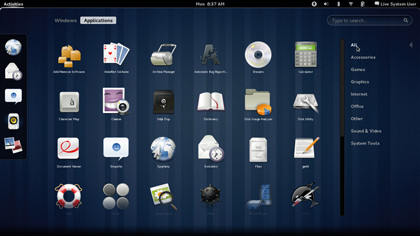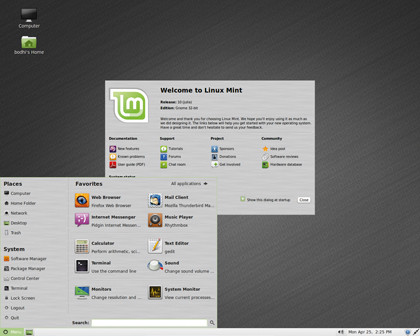Ubuntu 11.04 explored: a new dawn for Linux?
Groundbreaking release heralds the rise of the Unity desktop
It's a competitive distro market out there, so how does Natty compare?
Ubuntu 11.04 vs Fedora 15

Closely following the release of Ubuntu 11.04 and its Unity desktop, is Fedora 15 'Lovelock' with Gnome 3's default Gnome Shell desktop. Sure, there's the usual dose of changes and new additions as well (keep an eye out for our review), but the most notable difference is on the desktop.
Although both Fedora and Ubuntu have historically tinkered with the stock Gnome release and tweaked it to their own liking, never have the two distros looked so different.
The graphical differences stem from the choice of compositing window manager, with Ubuntu basing Unity on Compiz rather than Gnome 3's Mutter. Despite their visual differences, having used both Gnome Shell and Unity day-in day-out for several weeks, we think the two desktops aren't all that different for common tasks; both were designed to provide a better user experience.
Both desktops require 3D acceleration to take full advantage of the user interface improvements; both also ship with fallback modes for machines that don't meet their graphics requirements. And the developers have worked hard to ensure both closely resemble the "real thing".
With 11.04, Ubuntu has merged both its desktop and netbook distros. Gnome is also aiming for a consistent desktop across devices. Both interfaces are designed for touch-screen devices, yet can be controlled via the keyboard, and Zeitgeist plays an important part on both desktops.
Sign up for breaking news, reviews, opinion, top tech deals, and more.
Of the two, Gnome Shell is the one that has made bold changes, such as dropping the minimise and maximise window controls. The functionality is still there, and you can right-click on a window's title bar to minimise it, but removing the buttons caused a furore.
Both Gnome Shell and Unity handle minimised windows in much the same way though. In Unity, the Launcher points to minimised windows across workspaces, and in Gnome Shell all windows are visible in the Overview.
The most noticeable difference between the two desktops is Unity's global menus. Also, Unity doesn't have a panel at the bottom of the screen, while Gnome Shell has one that hides automatically and is used to display notifications. The Gnome Shell is also bundled with other mainstream desktop distros such as OpenSUSE and Debian Unstable, while no other distro besides Ubuntu has yet announced its plan to bundle Unity.
Ubuntu 11.04 vs Mint

One of the most popular distros built on top of Ubuntu is Mint, which trails an Ubuntu release by a couple of months. The developers use that time to extensively modify the Ubuntu codebase and make their Mint release stand on its own. In fact, one of the most popular features of Mint is its Mint Menu which is also being ported to other distros.
Mint's USP is that the distro is about usability, and its custom menu and custom update manager are examples of this. Katya, the upcoming version of Mint, will be based on Ubuntu 11.04, but the release will be considerably different from Natty, most notably, in that it will not ship with the Unity desktop.
In a blog post announcing the name of Mint's next release, founder and lead developer Clement Lefebvre wrote that Katya's desktop "will look similar to the one we're using at the moment". Despite this, Lefebvre added that Katya will ship with Gnome 3. That's another separation from Ubuntu 11.04, which ships with Unity on top of Gnome 2.32.
Details are sketchy and Lefebvre hadn't got back to us by the time we went to press. So we're not sure whether Katya's desktop will be the fallback mode of Gnome 3, or the Gnome Classic mode that Ubuntu 11.04 defaults to on machines that don't meet Unity's hardware requirements, or something else entirely. There's also no details as to what window manager Mint will go with.
It's important to remember that Mint's desktop was already very different to Ubuntu's. Instead of the panel on top, Mint grouped applications, places, and systems under its custom Mint Menu. The new Unity interface has no room for the Mint Menu, so Mint either had to drop it or stick with the classic look.
Ubuntu 11.04 vs Ubuntu 8.04

It might sound melodramatic, but Ubuntu has come a very long way and you don't have to go right back to 2004 to really see the difference. Cast your mind back just a few years - to 8.04 which was the distro's second Long Term Support (LTS) release - and you can see that Ubuntu was starting to be more adventurous.
The boldest move in that release was the inclusion of beta software in what was a LTS release (Firefox 3 beta 5 for the curious). We also remember 8.04 because it was the first release that shipped with the Windows-based Ubuntu installer, WUBI, which allowed Windows users to install Linux from within the familiar environment they felt safe in.
Interestingly, it was the first release that was criticised for its choice of graphical environment, although not for Gnome, but its decision to stick with KDE 3.5 for its KDE-based sibling Kubuntu.
Back then Ubuntu didn't consider KDE 4.0 which had been out for only a couple of months, because the bold, new desktop environment hadn't proved its stability credentials. Heard that one before anywhere?
From that point on, it would appear each subsequent Ubuntu release introduced new features in the build up to 11.04. Ubuntu 8.10 introduced a failsafe mode that would drop you to a minimal desktop if your graphics hardware wasn't supported. The state of drivers for 3D hardware, both in free software and proprietary form, has improved in leaps and bounds since then.
It was also around then that Ubuntu started eyeing netbooks with an option to create a USB bootdisk. In 9.10 Ubuntu added the immensely popular Software Centre, and closely integrated its Ubuntu One cloud service into the Gnome desktop.
The effort to make the desktop more social continued with 10.04 which debuted the MeMenu. We also remember that version because it bundled the Nvidia open source Nouveau drivers.
The stage was all set then for the 10.10 release, which broke from the convention of an August-end release, and was instead released on the 10 August, 2010. The date 101010 in binary equals 42, which as any geek worth his salt would know, is the answer to the "ultimate question". That release was all about the Unity interface for netbook users.
Now with 11.04, the Unity interface leaps from the confines of the netbook to the bigger real estate of the desktop. Is Ubuntu's answer to the "ultimate question" the correct one?
The politics of Ubuntu

Mark Shuttleworth announced that Ubuntu 11.04 would ship the Unity environment at the Ubuntu Developer Summit in October 2010. Up until that point, Unity was just the radically redesigned environment shipped on the Ubuntu Netbook Edition.
When announcing the Natty Narwhal name for the 11.04 release, Shuttleworth wrote: "Once Maverick is out the door we'll be turning our attention to making the most of the amazing capabilities of modern graphics hardware, both for outer beauty and inner efficiency. There's a lot more to GL than glitz and glamour, though we won't say no to either."
The announcement just acted as a catalyst in the battle brewing between Ubuntu and Gnome. Back in May 2010, Shuttleworth said both Unity and Gnome Shell were "complementary" for the Gnome Project. At that time the Unity interface was built on the Clutter toolkit, and used the Mutter window manager, the same as Gnome 3, but by the time of the UDS announcement, Ubuntu developers had started porting Unity to Compiz.
Tempest in a teapot
Many saw Ubuntu's move on Unity as a step away from Gnome. It took a lot of convincing but finally people began seeing Unity and Gnome Shell as two different approaches. In a blog post Dave Neary, former member of the Gnome board, wrote that Novell, Nokia, OpenMoko, Intel and OLPC had all at some point used the Gnome platform to build custom user interfaces.
What kicked up a stink with Unity was Ubuntu's open criticism of Gnome for not collaborating with the project. Shuttleworth and others from the Ubuntu project claim they offered Gnome help but it was rejected.
Gnome's version of the story is that Shuttleworth reacted without understanding the Gnome community's motivations and intentions. Jeff Waugh, a Canonical employee between his stints as director of the Gnome Foundation, has detailed the spat between Ubuntu and Gnome in a series of blog posts.
He writes that "from mid-2010, Mark Shuttleworth was criticising Gnome for not accepting Canonical contributions for "political reasons". Ultimately, that was used as public rationalisation for the jump to Unity".
KDE's project leader Aaron Seigo wrote that "the story is not so much about Gnome and Canonical as it is about Gnome and the rest of the free software desktop ecosystem and the regressive behaviour being demonstrated there".
Major releases of mainstream open source software are only the beginning. Both Gnome 3.0 with the Gnome Shell, and Ubuntu 11.04 with the Unity Shell, have repainted the open source desktop landscape. But they are far from done. It takes a release or two for major projects to implement decisions.
So far there aren't any plans for reconciliation between the two but expect some Qt love in the next Ubuntu release and Shuttleworth has already said they will keep investing in the 2D Unity experience built atop Qt.
Was it worth it?
Some will cringe at the sight of Unity, others will love it. However you feel, you can't really find fault with Ubuntu or Canonical's intention to rejuvenate the desktop.
Sure, it's raised the bar on hardware requirements, but that bar's still way lower than what competing proprietary operating systems demand. And despite the fact that there are lightweight distros especially tuned for older hardware, Ubuntu has put considerable effort into Unity's 2D interface.
If you forget Canonical's run-ins with Gnome, you have two beautiful desktop shells in Unity and Gnome Shell. Remember that there's an actively maintained PPA that'll install Gnome Shell on top of Ubuntu 11.04 and this is definitely a plus, from a purely options point of view.
But the bad blood doesn't reflect positively on the community. Be it throwing accusations at each other or trying to nibble away at revenue percentages. Although, as Shuttleworth puts it, "money is particularly contentious in a community that mixes volunteer and paid effort".
In a recent TuxRadar podcast we asked whether Canonical is good for free software? Many agreed it was. Fabian Scherschel who hosts the Linux Outlaws podcast said "Every company goes through some rough patches and makes mistakes (just look at the Red Hat of 2001) but that doesn't mean they can't come out into the light again".
We hope the Desktop Summit in Berlin, the conference organised by the Gnome and KDE communities, will give both sides an opportunity to start building bridges.

With almost two decades of writing and reporting on Linux, Mayank Sharma would like everyone to think he’s TechRadar Pro’s expert on the topic. Of course, he’s just as interested in other computing topics, particularly cybersecurity, cloud, containers, and coding.